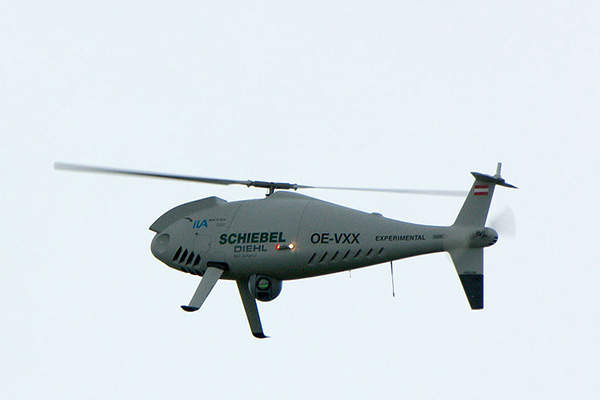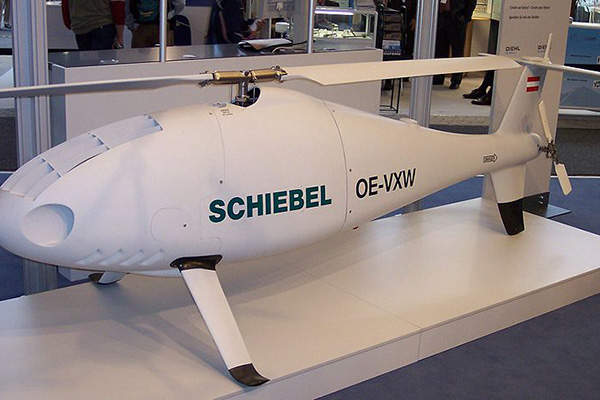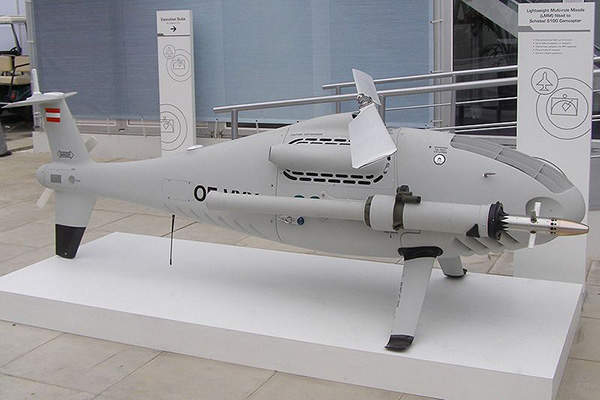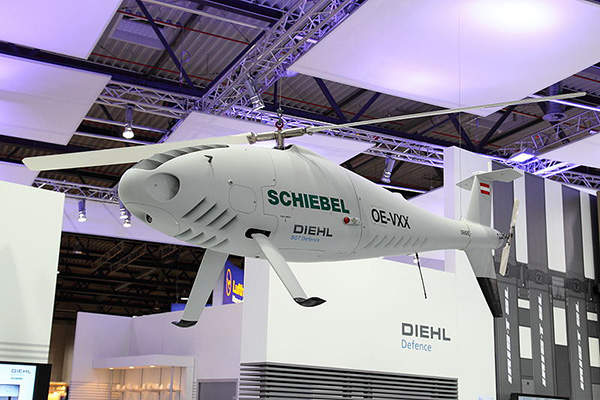Camcopter S-100 is an unmanned air system (UAS) designed and developed by Schiebel, a company based in Austria.
The unmanned system can be deployed for a variety of missions, including border and territorial water patrol, reconnaissance, search-and-rescue, countermeasures, anti-smuggling, route surveillance, convoy protection, psychological operations, damage assessment, task forces, pollution and oil spill monitoring, minefield mapping, and other command and control operations.
The UAS secured a Permit to Fly from the European Aviation Safety Agency in June 2007.
The Royal Thai Navy (RTN) placed an order with Schiebel for an undisclosed number of Camcopter S-100 systems in November 2019. The UAS will be deployed in Pakphanang District and on the RTN frigate fleet in 2020.
Camcopter S-100 design and features
The Camcopter S-100 UAS has automatic vertical take-off and landing (VTOL) capability and can perform operations in all weather conditions. It can operate on its own or as part of an intelligence, surveillance, target acquisition, and reconnaissance (ISTAR) network in joint operations.
Tanan 300 is a new generation vertical take-off and landing (VTOL) tactical unmanned aerial system (UAS) being built by Cassidian, an EADS company (now Airbus Defence and Space).
The unmanned system has a length of 3,110mm, main rotor diameter of 3,400mm and height of 1,120mm. The maximum take-off weight of the UAS is 200kg, while the empty weight and payload capacities are 110kg and 50kg respectively. The UAS can carry 57l of fuel in the internal tanks and features an external fuel tank. It can be optionally fitted with a harpoon deck capture system for use with any Nato grid.
Payloads on board Camcopter S-100 UAS
The Camcopter S-100 UAS is equipped with two payload bays and an auxiliary electronics bay. The stabilised day and night electro-optical / infra-red (EO / IR) sensors and thermal surveillance equipment help capture high-definition images, which are transmitted in real-time to the ground control station (GCS) via a line of sight data link with a 180km range.
The system can carry synthetic aperture radar (SAR), maritime radar, ground-penetrating radar (GPSAR), signal intelligence (SIGINT) and communication intelligence (COMINT), communication relays, ATMID all-terrain mine detector, light detection and ranging (LIDAR) scanners, loudspeakers, transponders, dropping containers and under-slung loads.
The UAS is also equipped with Remotely Operated Video Enhanced Receiver (ROVER) system for surveillance and two side payload hardpoints.
The system navigates using an inertial navigation system (INS) and a global positioning system (GPS), and is fitted with Riegl VQ-820-GU Hydrographic Airborne Sensor, Thales I-Master radar system and a CORONA 350 airborne sensor, and a Shine micro automatic identification system.
Ground control station
The Camcopter S-100 UAS is controlled by a Ground Control Station (GCS) equipped with two laptop computers, an intelligent interface, control screen and a control station. The GCS is used for mission planning, processing, retrieving and storing the information provided by the unmanned system.
Propulsion and performance of Camcopter S-100
The Camcopter S-100 UAS is powered by a Wankel-type rotary engine, which produces a power of 50hp. The engine runs on 100 octane-grade avgas or 95 octane lead-free petrol. The drone can be optionally powered by Schiebel’s heavy fuel engine, which supports the use of JP-5 (F-44), Jet A-1 (F-35) and JP-8 (F-34) fuels.
The UAS has a maximum airspeed of 130k and a typical cruise speed of 100k. It can execute missions up to six hours, flying at a loiter speed of 55k with a payload of 34kg.
The air system has a service ceiling of 18,000ft in international standard atmosphere (ISA) conditions and can operate in temperatures ranging from -40°C to 55°C.
Camcopter S-100 air system orders and deliveries
Schiebel was awarded a contract by the US Army to deliver a Camcopter S-100 for the humanitarian demining operations in March 1997. The UAS successfully demonstrated its naval and coast guard capabilities from the US Coast Guard Cutter, Valiant for the Joint Interagency Task Force (JIATF) East in August 2000.
The Egyptian Navy received a Camcopter S-100 UAS in 2002. The UAS performed a two-week border patrol exercise for the Austrian Ministry of Interior (Bundesministerium für Inneres – BM.I) in September 2006.
In December 2009, the French Direction Générale de l Armement (DGA) signed a contract with Schiebel to lease Camcopter S-100 UAS for the assistance of both land and coastal operations. A total of four trials were completed by August 2010.
In July 2010, Schiebel was awarded a contract by the King Abdullah Design and Development Bureau (KADDB) of Jordan for two Camcopter S-100 systems to assist the Jordan armed forces and the Royal Jordanian Air Force. The deliveries were concluded in February 2011.
French shipbuilder DCNS partnered with Schiebel in June 2011 for the integration of Camcopter S-100 with the French Navy’s Gowind class offshore patrol vessel, L’Adroit. The UAS was delivered to the French Navy in October 2011.
In February 2014, Schiebel received a contract from the Italian Navy to provide a Camcopter S-100 air system, training, integration and spares for anti-piracy missions.
The UAS demonstrated its maritime capabilities from a Dutch Navy vessel in the North Sea in April 2014.
Schiebel signed a contract with the Royal Australian Navy to provide its Camcopter S-100 system and logistics support for three years, in December 2016.
French shipbuilder DCNS partnered with Schiebel in June 2011 for the integration of Camcopter S-100 with the French Navy’s Gowind class offshore patrol vessel, L’Adroit. The UAS was delivered to the French Navy in October 2011.
Flight tests of the S-100 UAS
The UAS performed a series of flight tests from an offshore patrol vessel for the Indian Navy in the Arabian Sea in November 2007. It successfully conducted reconnaissance missions from the Pakistan Navy’s Type 21 frigate in the Arabian Sea in April 2008. In September 2008, the German Navy conducted flight trials of the UAS from the K130 Class corvettes for the intelligence, surveillance, target acquisition and reconnaissance (ISTAR) capabilities in the Baltic Sea.
The unmanned system demonstrated its maritime capabilities from the French Navy’s Montcalm frigate in the Mediterranean in October 2008. The Austrian Army conducted test flights of the UAS for field exercise in the military training area at Allentsteig, north of Vienna, in December 2008.
The UAS demonstrated psychological operations for the US Army Special Operations Command (USASOC) in December 2009. The UAS also demonstrated its capabilities to the Spanish military and government departments in November 2010.
The Italian Navy conducted a test flight of UAS from its Soldati Class frigate ITS Bersagliere in April 2012.
Global Unmanned Aerial Vehicles (UAV) Market 2011-2021
This project forms part of our recent analysis and forecasts of the global unmanned aerial vehicles (UAV) market available from our business information platform Strategic Defence Intelligence. For more information click here or contact us: EMEA: +44 20 7936 6783; Americas: +1 415 439 4914; Asia Pacific: +61 2 9947 9709 or via email.







.gif)
